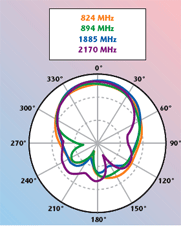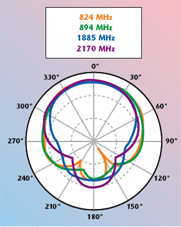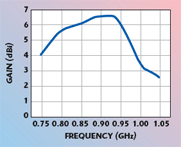
Microstrip patches are an attractive type of antenna because of their low cost, conformability and ease of manufacture. The aperture-coupled configuration1 also provides the advantage of isolating spurious feed radiation by using a common ground plane. The primary barrier to the implementation of these antennas in many applications, however, is their limited bandwidth, which is only of the order of a few percent for a typical patch radiator. Because of this, much work has been devoted to increasing the bandwidth of microstrip antennas. One technique that has been used is a near resonance aperture, resulting in a bandwidth of the order of 20 percent.2 Other techniques that have been used extensively are aperture-coupled stacked patch antennas with a bandwidth of 30 to 50 percent.3,4 A broadband, air-filled, stacked U-slot patch antenna has been studied where a bandwidth of the order of 44 percent can be achieved.5 A broadband, H-shaped, aperture-coupled, U-slot patch antenna6 with an impedance bandwidth of 21.7 percent has also been presented. In addition, a wideband microstrip patch antenna, with a tilted L-probe feeding7 and having an impedance bandwidth of 37.1 percent, has been described.
In this article, an alternative design technique that combines an L-shaped probe-fed, U-slot patch antenna with a coil is proposed. The L-shaped probe feed is used to enhance the impedance matching, necessary because of a low radiation resistance in the usable band. In addition, the coil contributes to a reduction of the antenna size and acts as a resonance device for the cellular band. A thick substrate is also used to enhance the bandwidth. The bandwidth characteristics of the proposed antenna depend highly on the thickness of the patch substrate as well as on the L-shaped feed line. The experimental impedance bandwidth is approximately 795 to 962 MHz and 1825 to 2308 MHz for a S11 less than –10 dB. Experimental results for the radiation patterns of the multi-band antenna are also presented.

Antenna Structure and Experimental Results
The geometry of an alternative design technique that combines an L-shaped probe-fed, U-slot patch antenna with a coil is shown in Figure 1. The design parameters of the antenna are: For the patch (i), lp = 52 mm, Wp = 71 mm; for the U-shaped slot (ii), lus = 33 mm, Wus = 40.5 mm; for the L-shaped probe feed (iii), llf = 38 mm, hlf = 5.5 mm; for the dielectric layer (iv), εrl = 4.6, l = 21 mm, h1 = 1.6 mm, tanδ2 = 0.0009; for the coil (v), lhe = 16.5 mm; and for the aluminum reflector (vi), lr = 148 mm, Wr = 160 mm, hr = 1.3 mm. The resonances of the coil and of the U-slot patch with probe feeding occur on either sides of the operating band. Since the U-slot patch is used as a radiator and a resonator, its length cannot be changed to control the impedance at the L-shaped feed line, as would be done ordinarily with an aperture-coupled patch. The L-shaped probe feeding is used to enhance the impedance matching. This is necessary because of the low radiation resistance in the usable band. In addition, a coil is used to reduce the size of the antenna and acts as a resonance device for the cellular band. A thick substrate is used to enhance the bandwidth. The bandwidth characteristics of the proposed antenna depend highly on the thickness of the substrate patch and the L-shaped feed line, which improve of the coupling and the impedance matching. A photograph of the fabricated antenna is shown in Figure 2.

The return loss of the antenna was measured with an HP8510 network analyzer. The antenna size, including the reflector, is 160 × 148 × 34.5 mm. The measured impedance bandwidths, shown in Figure 3, are approximately 795 to 962 MHz (19.8 percent at a center frequency of 880 MHz) and 1825 to 2308 MHz (24 percent at a center frequency of 2000 MHz), for a S11 of less than –10 dB. The experimental results for the return loss exhibit the dual-resonance characteristics of a multi-band of the antenna. After calibration using a horn antenna, the radiation patterns were measured. Figure 4 shows the measured x-z radiation patterns as a function of frequency. The half-beam width is approximately 90°. Figure 5 shows the measured y-z radiation patterns as a function of frequency. All the radiation patterns show good characteristics.
Figure 6 shows the measured gain versus frequency for the cellular and GSM bands. The gain is relatively high over most of the band, most probably because of the finite size of the antenna substrate, that is the power in the surface wave is not confined to the substrate but diffracted by the substrate edge, an effect which was not taken into account in the analysis. The measured gain is 5.5 dBi over the entire usable frequency band, but drops off rapidly past the band edges. The measured gain versus frequency in the PCS, IMT-2000 and WLL bands is shown in Figure 7. The measured gain is also 5.0 dBi over the entire usable frequency band, but drops off rapidly past the band edges. This is due to impedance mismatch and pattern degradation, as the back radiation level increases rapidly at these frequencies.

Conclusion
In this article, an L-shaped probe-fed, U-slot patch antenna with a coil was described. The L-shaped probe feed is used to enhance the impedance matching necessary because of a low radiation resistance in the usable band. The coil contributes to the antenna size reduction and acts as a resonance device for the cellular band. The measured results on this antenna show a multi-band characteristic. The proposed reduced size antenna can be used in practical applications such as cellular, GSM, PCS, IMT-2000 and WLL.
References
1. D.M. Pozar, “A Microstrip Antenna Aperture Coupled to a Microstripline,” Electronics Letters, Vol. 21, 1985, pp. 49–50.
2. F. Croq and A. Papiernik, “Large Bandwidth Aperture-coupled Microstrip Antenna,” Electronics Letters, Vol. 26, No. 16, 1990, pp. 1293–1294.

3. F. Croq and D.M. Pozar, “Millimeter-wave Design of a Wideband Aperture-coupled Stacked Microstrip Antenna,” IEEE Transactions on Antennas and Propagation, Vol. 39, 1996, pp. 1170–1176.
4. S.D. Targonski, R.B. Waterhouse and D.M. Pozar, “Wideband Aperture-coupled Stacked Patch Antenna Using Thick Substrates,” Electronics Letters, Vol. 32, No. 21, 1996, pp. 1941–1942.
5. B.L. Ooi and C.L. Lee, “Broadband Air-filled Stacked U-slot Patch Antenna,” Electronics Letters, Vol. 35, No. 7, 1999, pp. 515–516.
6. S.C. Gao, L.W. Li, M.S. Leong and T.S. Yeo, “Wideband Microstrip Antenna with an H-shaped Coupling Aperture,” IEEE Transactions on Vehicular Technology, Vol. 51, No. 1, January 2002, pp. 17–27.
7. D.S. Qi, B.H. Li and H.T. Liu, “Wideband Microstrip Patch Antenna with Tilted L-probe Feeding,” Microwave and Optical Technology Letters, Vol. 43, 2004, pp. 380–382.

Yong-Woong Jang received his BS and MS degrees from Myongji University, Seoul, Korea, in 1989 and 1991, respectively, and his PhD degree from Ajou University, Suwon, Korea, in 1999, all in electronics engineering. He became a member of the faculty of the department of electronics communication engineering at the College of Keukdong, Chungbuk, Korea, where he is now an associate professor. His main research interests include antennas, RF systems and numerical methods in solving electromagnetic problems.
Hyun-Chul Go received his BS and MS degrees in electronics engineering from the Korea University of Technology and Education, Cheonan, Korea, in 1999 and 2001, respectively. He worked as a research engineer in the R&D center of Hankook Antenna Co. Ltd. from 2001 to 2004. Since 2004, he has been working as a research engineer at the R&D center of AMC Centurion Korea Ltd. His current research interests include internal antennas, wideband and high gain antennas for repeaters, and UWB antennas.


Yong-Woong Jang

Hyun-Chul Go
